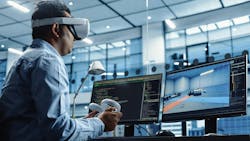Metaverse, big data, and how AI can drive next-gen manufacturing
The term “metaverse” was first used (as far as we know) in Neal Stephenson’s science fiction novel “Snow Crash” … way back in 1992. While the concept has been taking shape over the last 30 years, it wasn’t until 2010 that the first virtual reality headset was invented by Jason Rubin.
The release of the novel Ready Player One in 2011 opened our imaginations to the possibilities of collaboration, or competition, through a worldwide virtual reality game. In 2018 Rubin pressed Facebook’s Mark Zuckerberg to begin to build out the infrastructure for the metaverse and since then the technology has been playing catch-up with our imaginations.
See also: With AI, the time is now, say manufacturing technologists, futurist, 'evangelist'
What is the metaverse, really? McKinsey defines the metaverse as “the emerging 3D-enabled digital space that uses virtual reality, augmented reality, and other advanced internet and semiconductor technology to allow people to have lifelike personal and business experiences online.”
Today, we are in the midst of an explosion of possibilities way beyond gaming. In industries such as manufacturing, the metaverse is one of the most discussed topics of next-gen digital technologies. However, for organizations without robust data management and advanced AI capabilities, the merging of the virtual and physical worlds in manufacturing will not become a reality.
“The metaverse is here, and it’s not only transforming how we see the world but how we participate in it—from the factory floor to the meeting room,” said Microsoft Chairman and CEO Satya Nadella.
Metaverse manufacturing use cases
The metaverse brings greater efficiency and benefits to manufacturing throughout the value chain, starting with product design and development to servicing customers after products are delivered. It’s also an ideal tool for workforce training. Manufacturing use cases can include:
Product development
The metaverse can enable virtual shared spaces where engineers exchange ideas and remotely collaborate on design and technical aspects of development. In the metaverse, stakeholders can observe the design process and share ideas in real-time, accelerating time-to-market.
Digital twin
To some extent, the metaverse can be considered an extension of the digital twin in manufacturing. Digital twins are virtual representations of physical assets, processes, or systems created using real-time data from sensors and other sources used to simulate, predict, and optimize the performance of physical counterparts for purposes such as design optimization, predictive maintenance, and process improvement.
See also: Digital twin shortens design process by 30%, case study says
The integration of digital twins into the metaverse provides a fully immersive virtual shared space for manufacturing to collaborate on digital replicas of physical assets enabled with industrial IoT (IIoT) sensors and related AI algorithms. Once the pertinent data is available, the digital model can be used to perform diverse simulations, identify performance issues, and propose potential improvements. Engineers can collaborate in the virtual environment with the primary goal of obtaining valuable insights that can enhance the performance of the physical entity.
According to the survey done by Deloitte, “92% of companies surveyed are experimenting with or implementing at least one metaverse use case, and most are running six or more.” According to the survey, process simulation and real-time monitoring/digital twin were the two most common Metaverse use cases.
Market research
Discrete manufacturing companies are increasingly focusing on the end-consumer, both in understanding their sometimes-fickle needs and desires as well as in bringing products to markets in an ever-changing world. Manufacturers can create virtual showrooms to showcase and test products with customers in immersive ways, leading to improved customer experiences and increased market acceptance when the product is delivered.
Workforce training
The metaverse can also be used to create realistic simulations for workforce or user training purposes, such as operating complex machinery or handling hazardous materials. By creating an immersive environment where users can practice equipment operations and production lines safely, instead of using actual physical equipment which can be capital-intensive and dangerous. Training in the metaverse can improve safety and reduce the risk of accidents in real-world settings.
How to realize the metaverse in manufacturing
The metaverse represents an evolution of multiple existing and innovative technologies that need to integrate seamlessly to enable ubiquitous experiences for end users and organizations. Many advanced technologies are required including a big data management platform, augmented reality, AI algorithms, virtual reality, Blockchain, Digital twin, and edge computing capabilities. Additionally, the advent of 5G and 6G enables faster interaction with low latency between devices and systems without a physical line.
The role of data in the metaverse
At the heart of the metaverse will be the generation and processing of unprecedented masses of data. From this perspective, the metaverse can be divided into four layers:
- Data generation: This layer enables interaction between the physical and digital worlds. It could be users manipulating avatars using brain-computer interfaces, robots, and other devices like sensors on the factory equipment.
- Network: This layer is a very low-latency network that enables more real-time interactions. Technologies like 5G and 6G networks can guarantee these real-time interactions.
- Data processing: The data processing layer includes cloud computing, edge computing, data transformation and data engineering.
- Presentation: The presentation or visualization layer includes things like spatial mapping.
With the metaverse, organizations can also collect rich information about users. Companies can use this information to personalize services and create unique experiences for users.
See also: VR on the factory floor boosts safety, innovation, efficiency
Data science and AI will play an important role in extracting useful information from massive amounts of data. In addition, a cloud data platform is the basis of data management and analysis and is crucial for manufacturing in the metaverse for several reasons:
Scalability: The metaverse generates vast amounts of data from various sources, such as IoT sensors, machines, and virtual interactions. Most of these capabilities are best served in a cloud-based platform, however, each manufacturer is unique, and some might decide that all or part of these functions are better executed in an on-premises environment, requiring a hybrid cloud approach. A hybrid cloud data platform can more easily scale to handle this volume of data, ensuring that manufacturing operations in the metaverse can function smoothly.
Data Integration: Manufacturing in the metaverse involves multiple technologies and systems. A cloud data platform can integrate data from these diverse sources, providing a unified view of operations and enabling better decision-making.
See also: Your competitors are using AI. Why risk falling behind them?
Real-time Insights: The metaverse enables real-time monitoring and control of manufacturing processes, training and design. A cloud data platform is needed to process and analyze data in real time, providing insights that can help optimize operations and improve efficiency.
Security: The metaverse presents new security challenges, such as protecting digital identity, virtual assets and ensuring the integrity of virtual environments. A hybrid cloud data platform can provide robust security measures to protect manufacturing operations in the metaverse.
About the Author

Monique Hesseling
Monique Hesseling is the global senior managing director, Industry Solutions, for Cloudera, a U.S.-based data lake software company. Over the last 30-plus years, she has held senior business leadership positions at insurance, FSI, and technology companies, ranging from large commercial sales to product management and marketing. She started her career as an insurance broker, helping manufacturers with their risk management and insurance needs.
